Business Report on Primark: Primary and Secondary Data Analysis
VerifiedAdded on 2023/01/12
|18
|3589
|26
Report
AI Summary
This business report examines Primark's market expansion strategy, focusing on primary and secondary data analysis. The report begins with an executive summary and introduction, outlining the objectives and scope of the research. The main body details the methodology used, including the collection of primary data through questionnaires administered to Primark customers in London, exploring their preferences regarding gender, age, shopping frequency, and preferred product ranges. The report also incorporates secondary data analysis to compare Primark's market share and gross profit with its competitors over three years. Findings are presented using frequency distribution and percentages, visualized with bar graphs and pie charts. The conclusion and recommendations summarize key insights and suggest strategies for Primark's market expansion. References and an appendix with the questionnaire are included. The report's findings suggest that Primark should focus on attracting women, offering monthly discounts, and emphasizing exclusive and luxury fashion products, especially in city square locations and shopping malls, to effectively expand its market presence. This report is an example of the kind of resources available on Desklib, a platform which provides all the necessary AI based study tools for students.
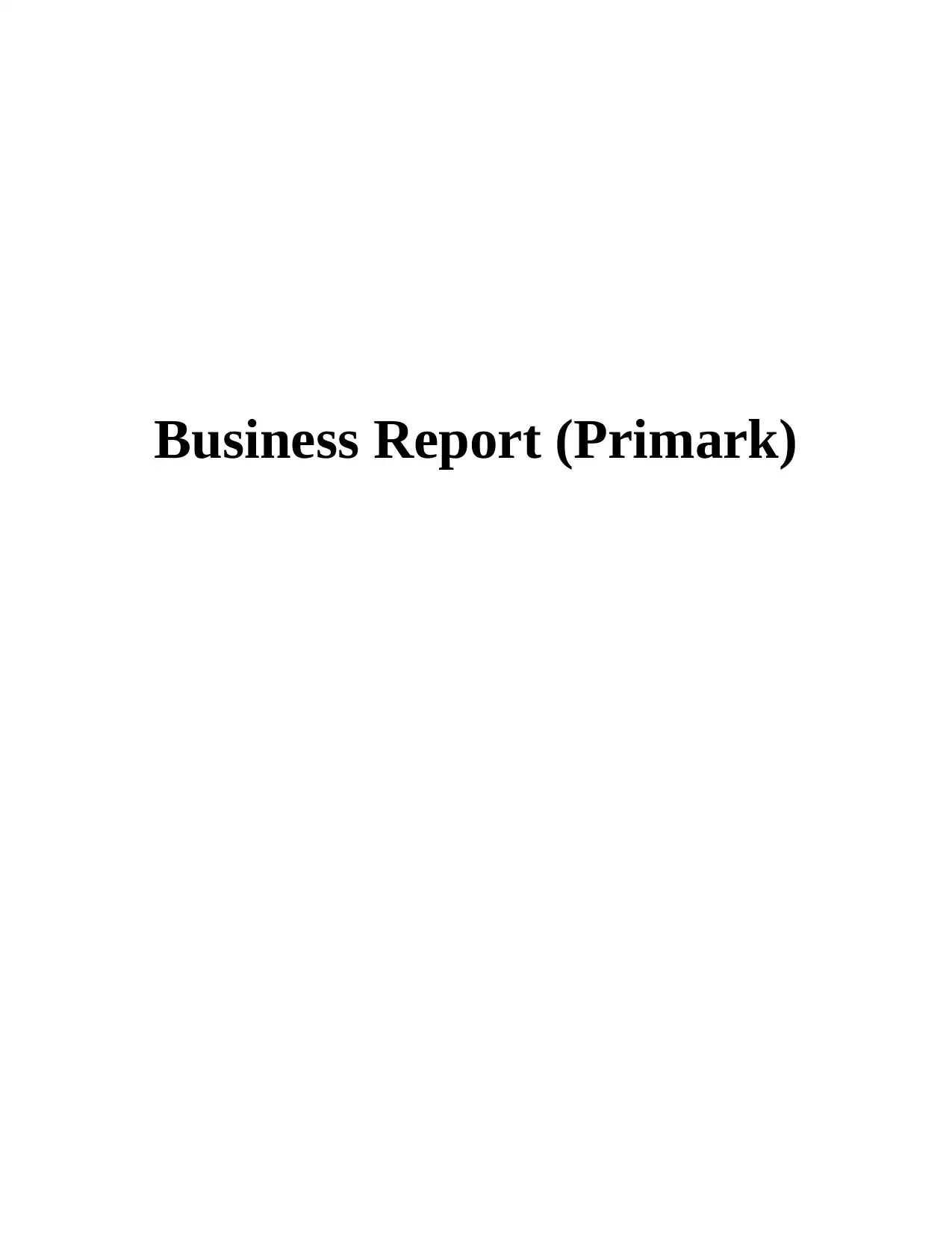
Business Report (Primark)
Paraphrase This Document
Need a fresh take? Get an instant paraphrase of this document with our AI Paraphraser
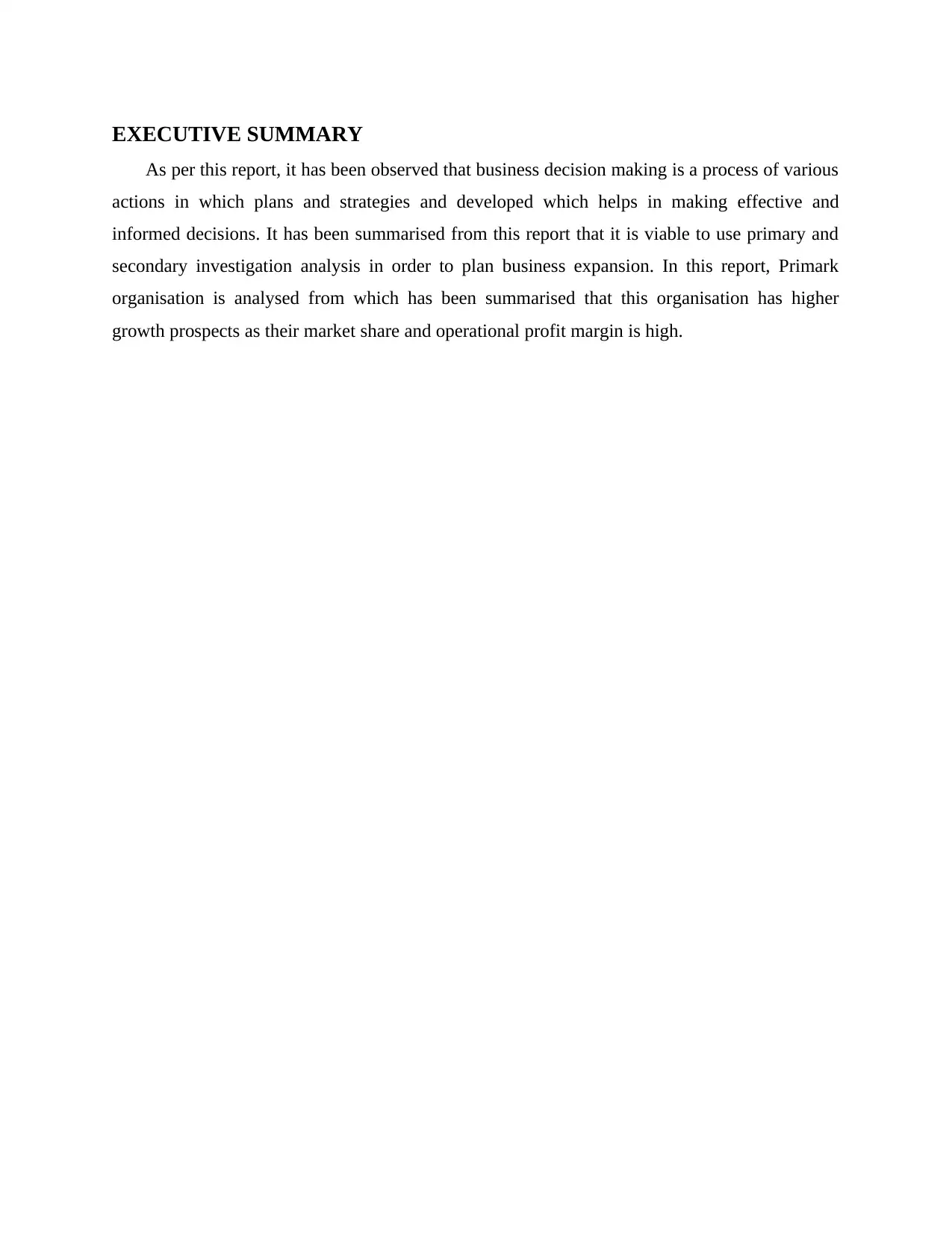
EXECUTIVE SUMMARY
As per this report, it has been observed that business decision making is a process of various
actions in which plans and strategies and developed which helps in making effective and
informed decisions. It has been summarised from this report that it is viable to use primary and
secondary investigation analysis in order to plan business expansion. In this report, Primark
organisation is analysed from which has been summarised that this organisation has higher
growth prospects as their market share and operational profit margin is high.
As per this report, it has been observed that business decision making is a process of various
actions in which plans and strategies and developed which helps in making effective and
informed decisions. It has been summarised from this report that it is viable to use primary and
secondary investigation analysis in order to plan business expansion. In this report, Primark
organisation is analysed from which has been summarised that this organisation has higher
growth prospects as their market share and operational profit margin is high.
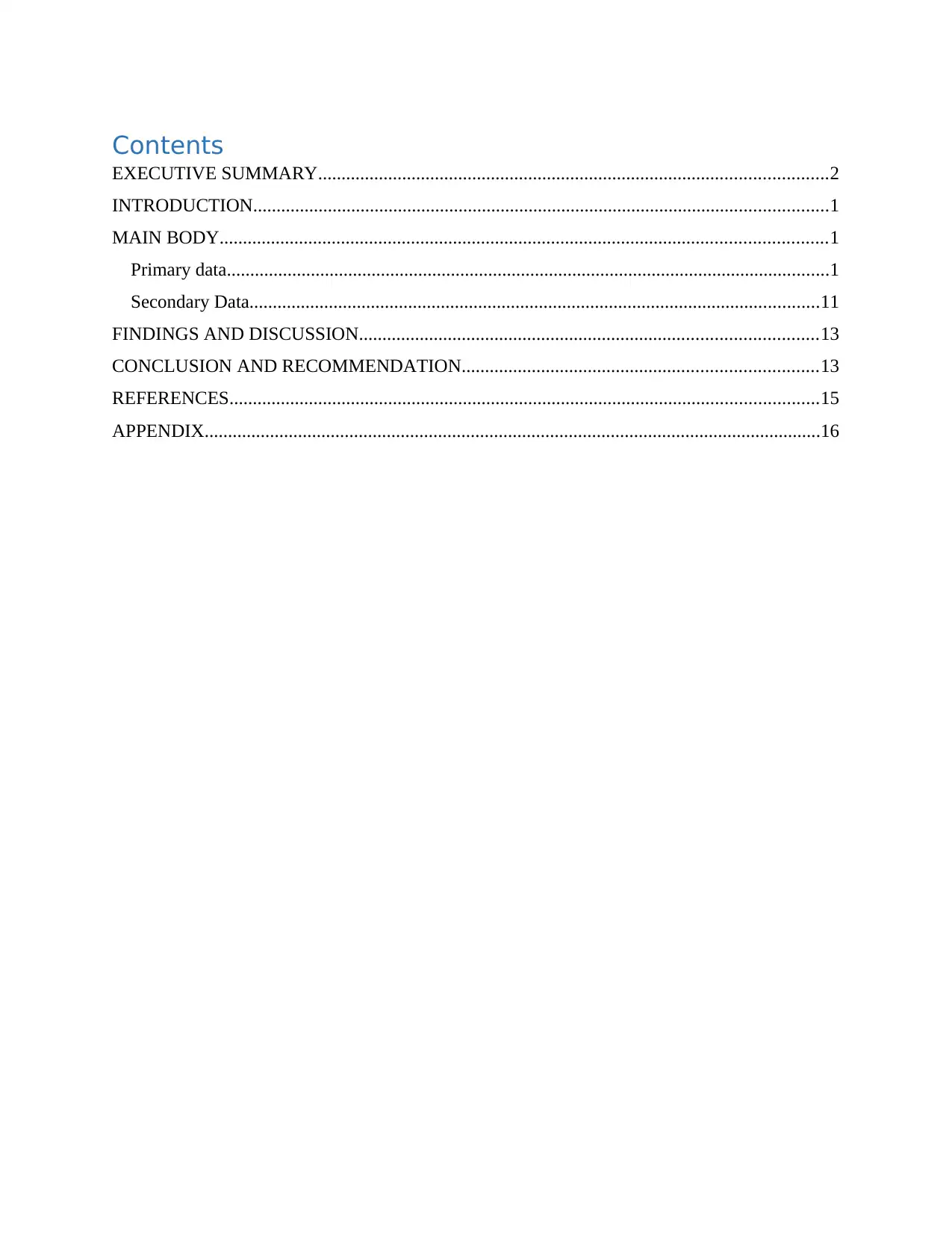
Contents
EXECUTIVE SUMMARY.............................................................................................................2
INTRODUCTION...........................................................................................................................1
MAIN BODY..................................................................................................................................1
Primary data.................................................................................................................................1
Secondary Data..........................................................................................................................11
FINDINGS AND DISCUSSION..................................................................................................13
CONCLUSION AND RECOMMENDATION............................................................................13
REFERENCES..............................................................................................................................15
APPENDIX....................................................................................................................................16
EXECUTIVE SUMMARY.............................................................................................................2
INTRODUCTION...........................................................................................................................1
MAIN BODY..................................................................................................................................1
Primary data.................................................................................................................................1
Secondary Data..........................................................................................................................11
FINDINGS AND DISCUSSION..................................................................................................13
CONCLUSION AND RECOMMENDATION............................................................................13
REFERENCES..............................................................................................................................15
APPENDIX....................................................................................................................................16
⊘ This is a preview!⊘
Do you want full access?
Subscribe today to unlock all pages.

Trusted by 1+ million students worldwide
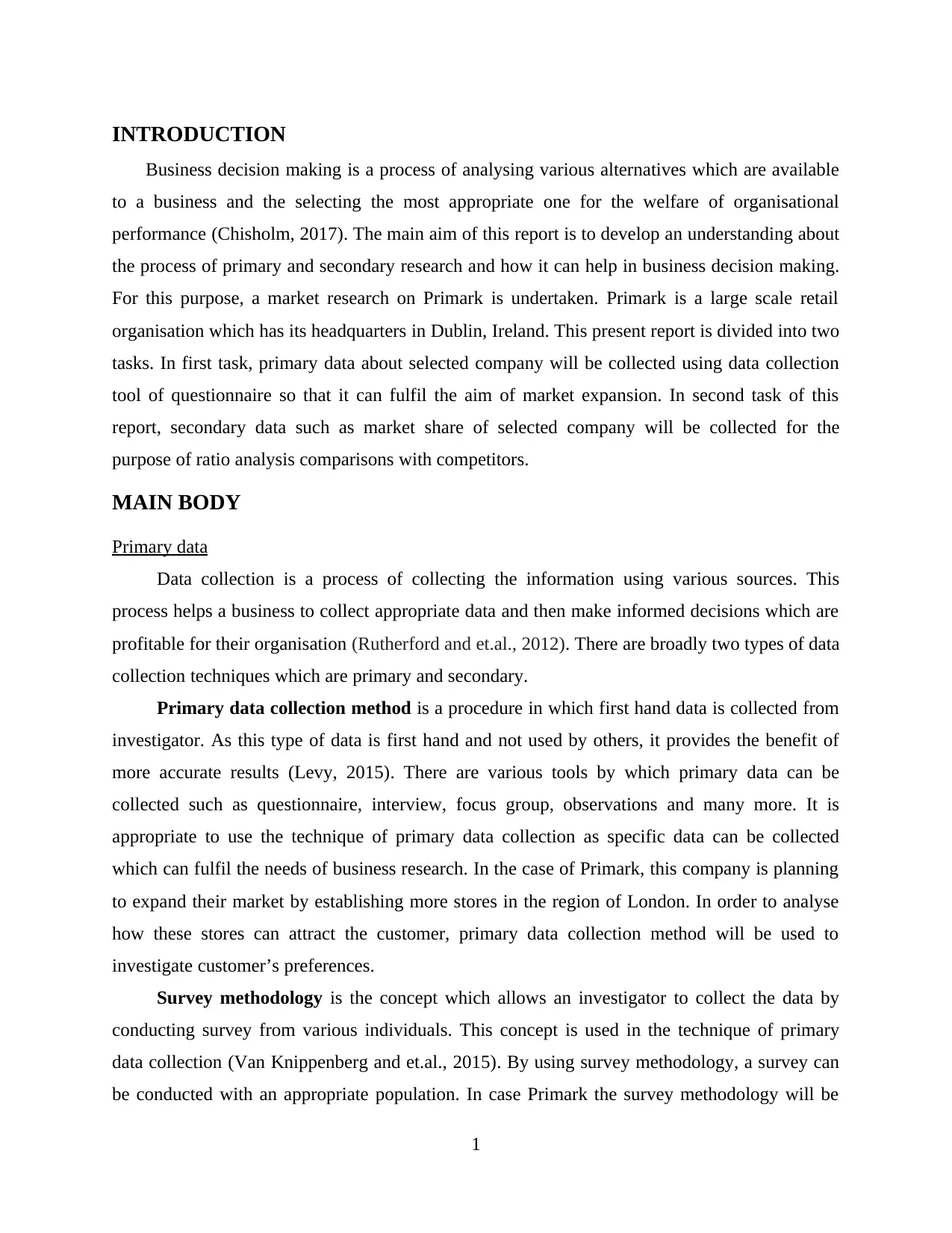
INTRODUCTION
Business decision making is a process of analysing various alternatives which are available
to a business and the selecting the most appropriate one for the welfare of organisational
performance (Chisholm, 2017). The main aim of this report is to develop an understanding about
the process of primary and secondary research and how it can help in business decision making.
For this purpose, a market research on Primark is undertaken. Primark is a large scale retail
organisation which has its headquarters in Dublin, Ireland. This present report is divided into two
tasks. In first task, primary data about selected company will be collected using data collection
tool of questionnaire so that it can fulfil the aim of market expansion. In second task of this
report, secondary data such as market share of selected company will be collected for the
purpose of ratio analysis comparisons with competitors.
MAIN BODY
Primary data
Data collection is a process of collecting the information using various sources. This
process helps a business to collect appropriate data and then make informed decisions which are
profitable for their organisation (Rutherford and et.al., 2012). There are broadly two types of data
collection techniques which are primary and secondary.
Primary data collection method is a procedure in which first hand data is collected from
investigator. As this type of data is first hand and not used by others, it provides the benefit of
more accurate results (Levy, 2015). There are various tools by which primary data can be
collected such as questionnaire, interview, focus group, observations and many more. It is
appropriate to use the technique of primary data collection as specific data can be collected
which can fulfil the needs of business research. In the case of Primark, this company is planning
to expand their market by establishing more stores in the region of London. In order to analyse
how these stores can attract the customer, primary data collection method will be used to
investigate customer’s preferences.
Survey methodology is the concept which allows an investigator to collect the data by
conducting survey from various individuals. This concept is used in the technique of primary
data collection (Van Knippenberg and et.al., 2015). By using survey methodology, a survey can
be conducted with an appropriate population. In case Primark the survey methodology will be
1
Business decision making is a process of analysing various alternatives which are available
to a business and the selecting the most appropriate one for the welfare of organisational
performance (Chisholm, 2017). The main aim of this report is to develop an understanding about
the process of primary and secondary research and how it can help in business decision making.
For this purpose, a market research on Primark is undertaken. Primark is a large scale retail
organisation which has its headquarters in Dublin, Ireland. This present report is divided into two
tasks. In first task, primary data about selected company will be collected using data collection
tool of questionnaire so that it can fulfil the aim of market expansion. In second task of this
report, secondary data such as market share of selected company will be collected for the
purpose of ratio analysis comparisons with competitors.
MAIN BODY
Primary data
Data collection is a process of collecting the information using various sources. This
process helps a business to collect appropriate data and then make informed decisions which are
profitable for their organisation (Rutherford and et.al., 2012). There are broadly two types of data
collection techniques which are primary and secondary.
Primary data collection method is a procedure in which first hand data is collected from
investigator. As this type of data is first hand and not used by others, it provides the benefit of
more accurate results (Levy, 2015). There are various tools by which primary data can be
collected such as questionnaire, interview, focus group, observations and many more. It is
appropriate to use the technique of primary data collection as specific data can be collected
which can fulfil the needs of business research. In the case of Primark, this company is planning
to expand their market by establishing more stores in the region of London. In order to analyse
how these stores can attract the customer, primary data collection method will be used to
investigate customer’s preferences.
Survey methodology is the concept which allows an investigator to collect the data by
conducting survey from various individuals. This concept is used in the technique of primary
data collection (Van Knippenberg and et.al., 2015). By using survey methodology, a survey can
be conducted with an appropriate population. In case Primark the survey methodology will be
1
Paraphrase This Document
Need a fresh take? Get an instant paraphrase of this document with our AI Paraphraser
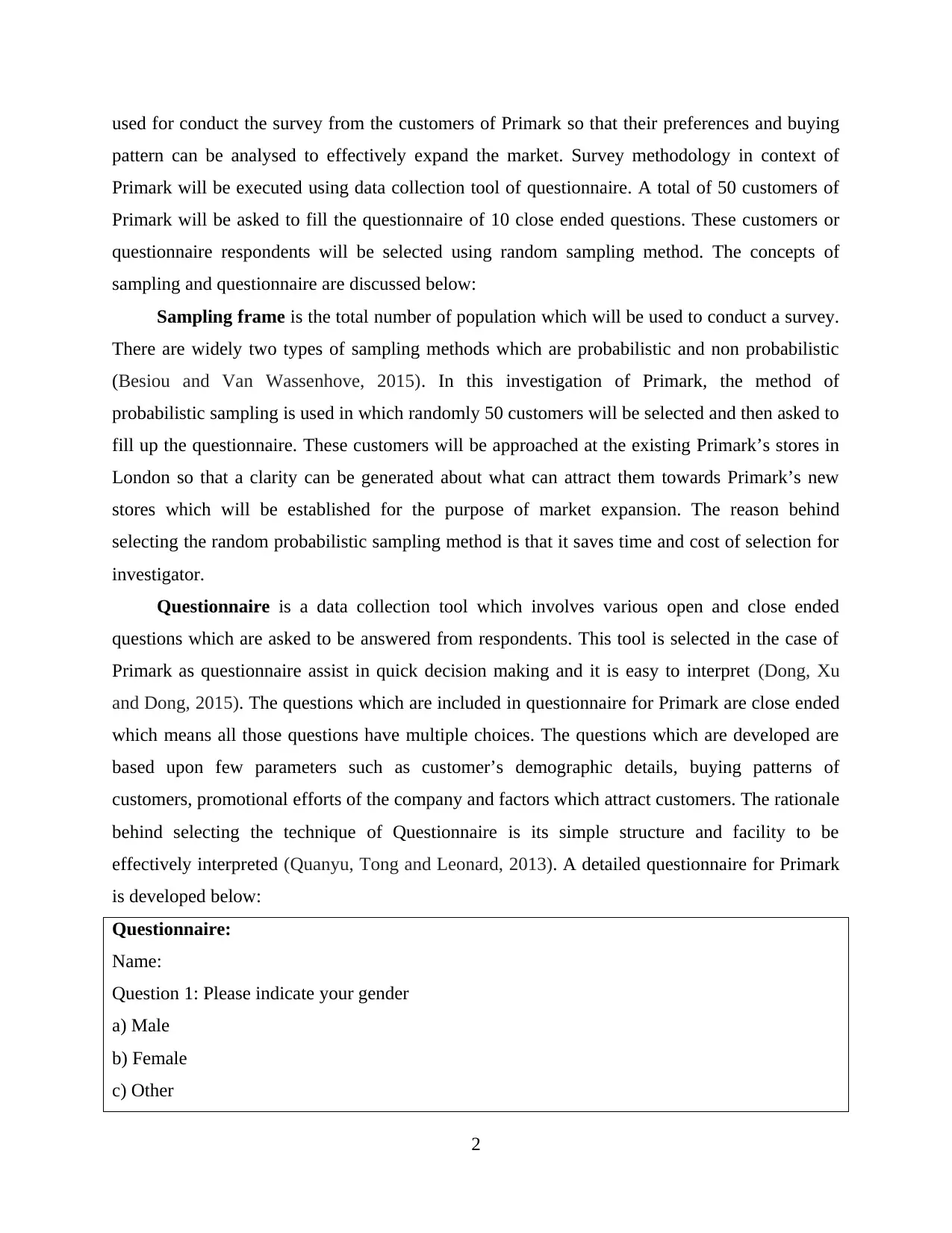
used for conduct the survey from the customers of Primark so that their preferences and buying
pattern can be analysed to effectively expand the market. Survey methodology in context of
Primark will be executed using data collection tool of questionnaire. A total of 50 customers of
Primark will be asked to fill the questionnaire of 10 close ended questions. These customers or
questionnaire respondents will be selected using random sampling method. The concepts of
sampling and questionnaire are discussed below:
Sampling frame is the total number of population which will be used to conduct a survey.
There are widely two types of sampling methods which are probabilistic and non probabilistic
(Besiou and Van Wassenhove, 2015). In this investigation of Primark, the method of
probabilistic sampling is used in which randomly 50 customers will be selected and then asked to
fill up the questionnaire. These customers will be approached at the existing Primark’s stores in
London so that a clarity can be generated about what can attract them towards Primark’s new
stores which will be established for the purpose of market expansion. The reason behind
selecting the random probabilistic sampling method is that it saves time and cost of selection for
investigator.
Questionnaire is a data collection tool which involves various open and close ended
questions which are asked to be answered from respondents. This tool is selected in the case of
Primark as questionnaire assist in quick decision making and it is easy to interpret (Dong, Xu
and Dong, 2015). The questions which are included in questionnaire for Primark are close ended
which means all those questions have multiple choices. The questions which are developed are
based upon few parameters such as customer’s demographic details, buying patterns of
customers, promotional efforts of the company and factors which attract customers. The rationale
behind selecting the technique of Questionnaire is its simple structure and facility to be
effectively interpreted (Quanyu, Tong and Leonard, 2013). A detailed questionnaire for Primark
is developed below:
Questionnaire:
Name:
Question 1: Please indicate your gender
a) Male
b) Female
c) Other
2
pattern can be analysed to effectively expand the market. Survey methodology in context of
Primark will be executed using data collection tool of questionnaire. A total of 50 customers of
Primark will be asked to fill the questionnaire of 10 close ended questions. These customers or
questionnaire respondents will be selected using random sampling method. The concepts of
sampling and questionnaire are discussed below:
Sampling frame is the total number of population which will be used to conduct a survey.
There are widely two types of sampling methods which are probabilistic and non probabilistic
(Besiou and Van Wassenhove, 2015). In this investigation of Primark, the method of
probabilistic sampling is used in which randomly 50 customers will be selected and then asked to
fill up the questionnaire. These customers will be approached at the existing Primark’s stores in
London so that a clarity can be generated about what can attract them towards Primark’s new
stores which will be established for the purpose of market expansion. The reason behind
selecting the random probabilistic sampling method is that it saves time and cost of selection for
investigator.
Questionnaire is a data collection tool which involves various open and close ended
questions which are asked to be answered from respondents. This tool is selected in the case of
Primark as questionnaire assist in quick decision making and it is easy to interpret (Dong, Xu
and Dong, 2015). The questions which are included in questionnaire for Primark are close ended
which means all those questions have multiple choices. The questions which are developed are
based upon few parameters such as customer’s demographic details, buying patterns of
customers, promotional efforts of the company and factors which attract customers. The rationale
behind selecting the technique of Questionnaire is its simple structure and facility to be
effectively interpreted (Quanyu, Tong and Leonard, 2013). A detailed questionnaire for Primark
is developed below:
Questionnaire:
Name:
Question 1: Please indicate your gender
a) Male
b) Female
c) Other
2
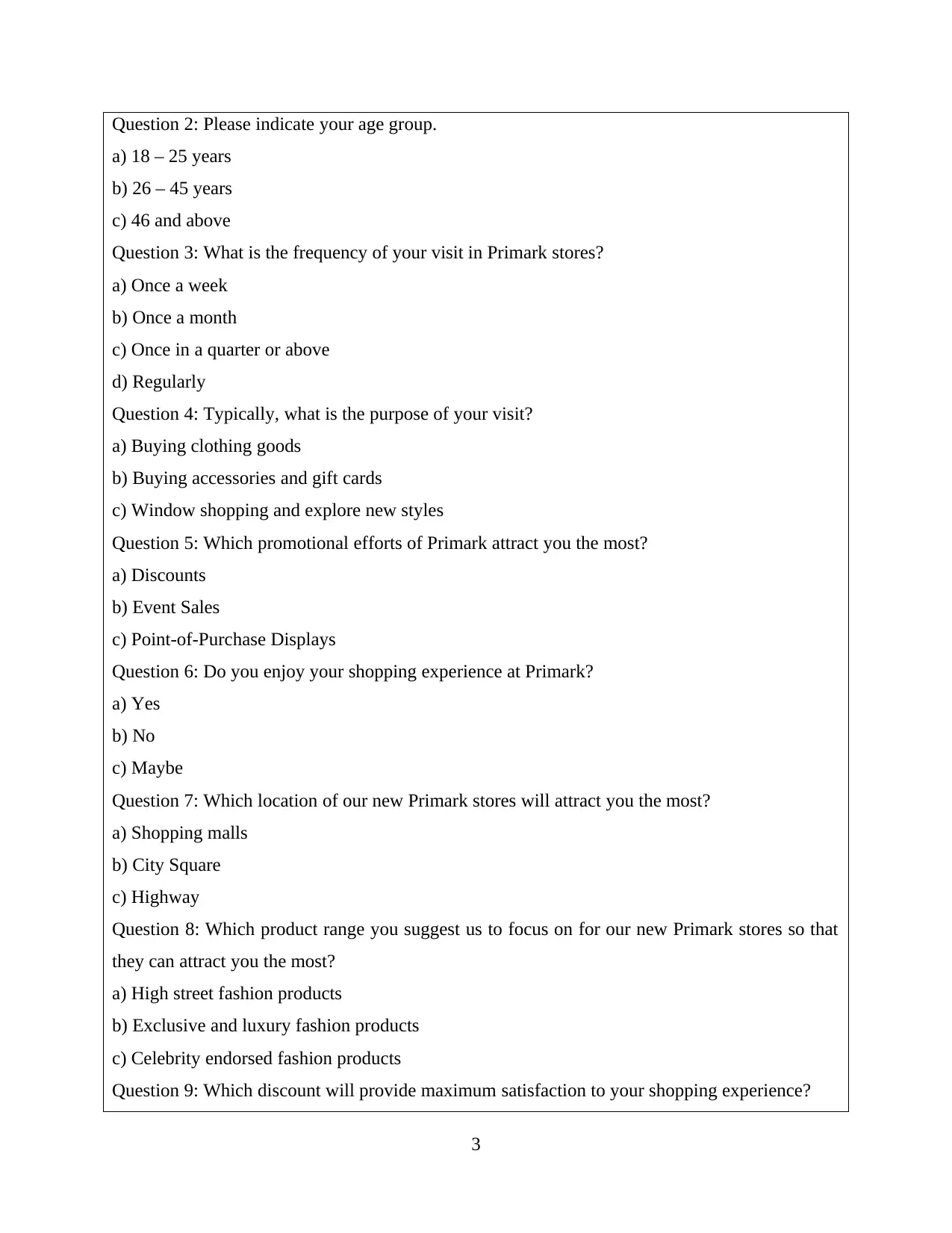
Question 2: Please indicate your age group.
a) 18 – 25 years
b) 26 – 45 years
c) 46 and above
Question 3: What is the frequency of your visit in Primark stores?
a) Once a week
b) Once a month
c) Once in a quarter or above
d) Regularly
Question 4: Typically, what is the purpose of your visit?
a) Buying clothing goods
b) Buying accessories and gift cards
c) Window shopping and explore new styles
Question 5: Which promotional efforts of Primark attract you the most?
a) Discounts
b) Event Sales
c) Point-of-Purchase Displays
Question 6: Do you enjoy your shopping experience at Primark?
a) Yes
b) No
c) Maybe
Question 7: Which location of our new Primark stores will attract you the most?
a) Shopping malls
b) City Square
c) Highway
Question 8: Which product range you suggest us to focus on for our new Primark stores so that
they can attract you the most?
a) High street fashion products
b) Exclusive and luxury fashion products
c) Celebrity endorsed fashion products
Question 9: Which discount will provide maximum satisfaction to your shopping experience?
3
a) 18 – 25 years
b) 26 – 45 years
c) 46 and above
Question 3: What is the frequency of your visit in Primark stores?
a) Once a week
b) Once a month
c) Once in a quarter or above
d) Regularly
Question 4: Typically, what is the purpose of your visit?
a) Buying clothing goods
b) Buying accessories and gift cards
c) Window shopping and explore new styles
Question 5: Which promotional efforts of Primark attract you the most?
a) Discounts
b) Event Sales
c) Point-of-Purchase Displays
Question 6: Do you enjoy your shopping experience at Primark?
a) Yes
b) No
c) Maybe
Question 7: Which location of our new Primark stores will attract you the most?
a) Shopping malls
b) City Square
c) Highway
Question 8: Which product range you suggest us to focus on for our new Primark stores so that
they can attract you the most?
a) High street fashion products
b) Exclusive and luxury fashion products
c) Celebrity endorsed fashion products
Question 9: Which discount will provide maximum satisfaction to your shopping experience?
3
⊘ This is a preview!⊘
Do you want full access?
Subscribe today to unlock all pages.

Trusted by 1+ million students worldwide
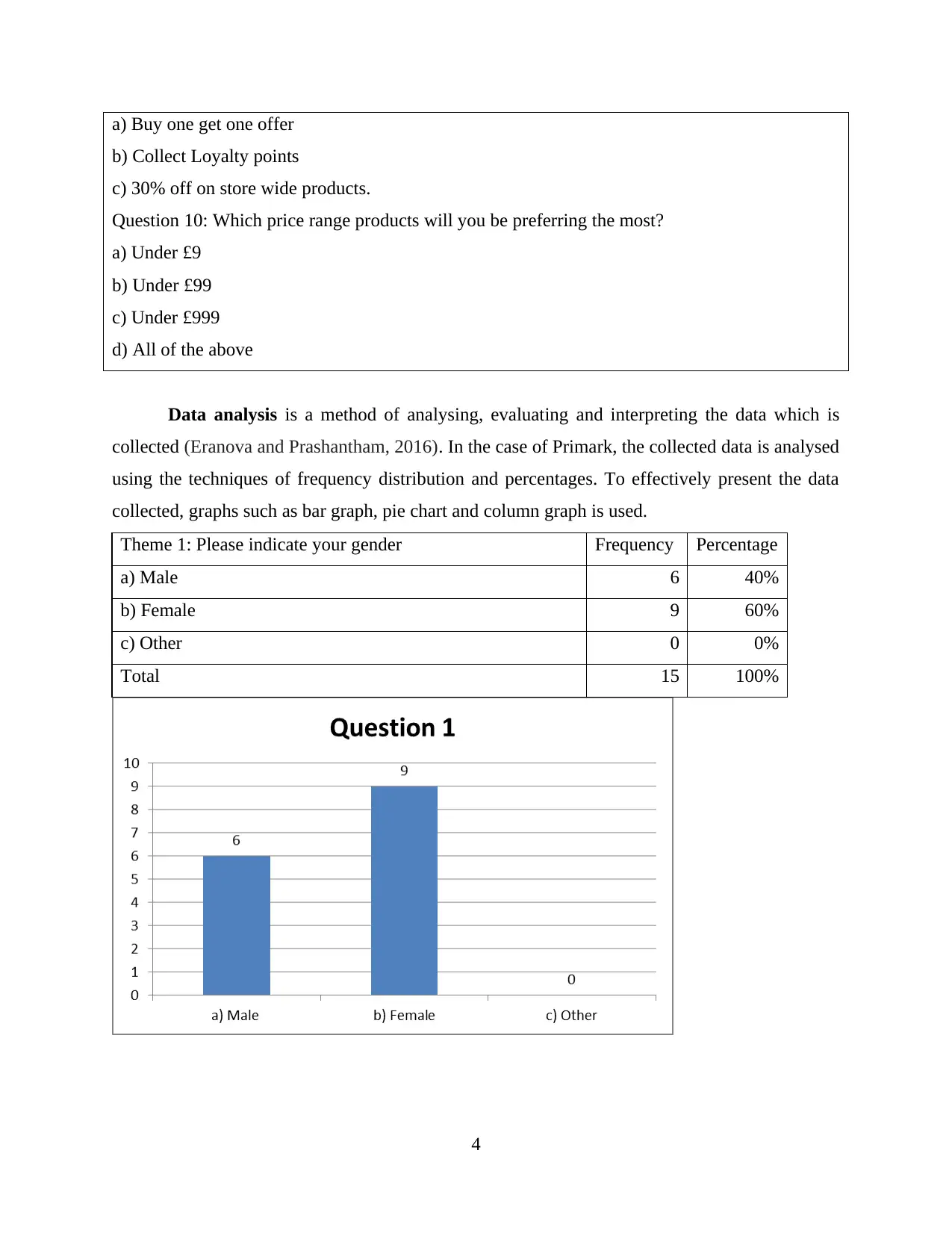
a) Buy one get one offer
b) Collect Loyalty points
c) 30% off on store wide products.
Question 10: Which price range products will you be preferring the most?
a) Under £9
b) Under £99
c) Under £999
d) All of the above
Data analysis is a method of analysing, evaluating and interpreting the data which is
collected (Eranova and Prashantham, 2016). In the case of Primark, the collected data is analysed
using the techniques of frequency distribution and percentages. To effectively present the data
collected, graphs such as bar graph, pie chart and column graph is used.
Theme 1: Please indicate your gender Frequency Percentage
a) Male 6 40%
b) Female 9 60%
c) Other 0 0%
Total 15 100%
4
b) Collect Loyalty points
c) 30% off on store wide products.
Question 10: Which price range products will you be preferring the most?
a) Under £9
b) Under £99
c) Under £999
d) All of the above
Data analysis is a method of analysing, evaluating and interpreting the data which is
collected (Eranova and Prashantham, 2016). In the case of Primark, the collected data is analysed
using the techniques of frequency distribution and percentages. To effectively present the data
collected, graphs such as bar graph, pie chart and column graph is used.
Theme 1: Please indicate your gender Frequency Percentage
a) Male 6 40%
b) Female 9 60%
c) Other 0 0%
Total 15 100%
4
Paraphrase This Document
Need a fresh take? Get an instant paraphrase of this document with our AI Paraphraser

Interpretation: From the above analysis, it has been analysed that most of the customers
who visit to the Primark store are women. This provides decision base to this company that they
should focus upon attracting women customers more.
Theme 2: Please indicate your age group. Frequency Percentage
a) 18 – 25 years 6 40%
b) 26 – 45 years 6 40%
d) 46 and above 3 20%
Total 15 100%
Interpretation: From the frequency distribution analysis conducted above, it can be seen
that majority of customers of Primark belong to the age group of 18-45. The total percentage of
this group is accumulated at 80%. Only 20% customers of this company aged 46 or above.
Theme 3: Once a month is the highest frequency of customer
visit in Primark stores. Frequency Percentage
a) Once a week 2 13%
b) Once a month 7 47%
c) Once in a quarter or above 5 33%
d) Regularly 1 7%
Total 15 100%
5
who visit to the Primark store are women. This provides decision base to this company that they
should focus upon attracting women customers more.
Theme 2: Please indicate your age group. Frequency Percentage
a) 18 – 25 years 6 40%
b) 26 – 45 years 6 40%
d) 46 and above 3 20%
Total 15 100%
Interpretation: From the frequency distribution analysis conducted above, it can be seen
that majority of customers of Primark belong to the age group of 18-45. The total percentage of
this group is accumulated at 80%. Only 20% customers of this company aged 46 or above.
Theme 3: Once a month is the highest frequency of customer
visit in Primark stores. Frequency Percentage
a) Once a week 2 13%
b) Once a month 7 47%
c) Once in a quarter or above 5 33%
d) Regularly 1 7%
Total 15 100%
5
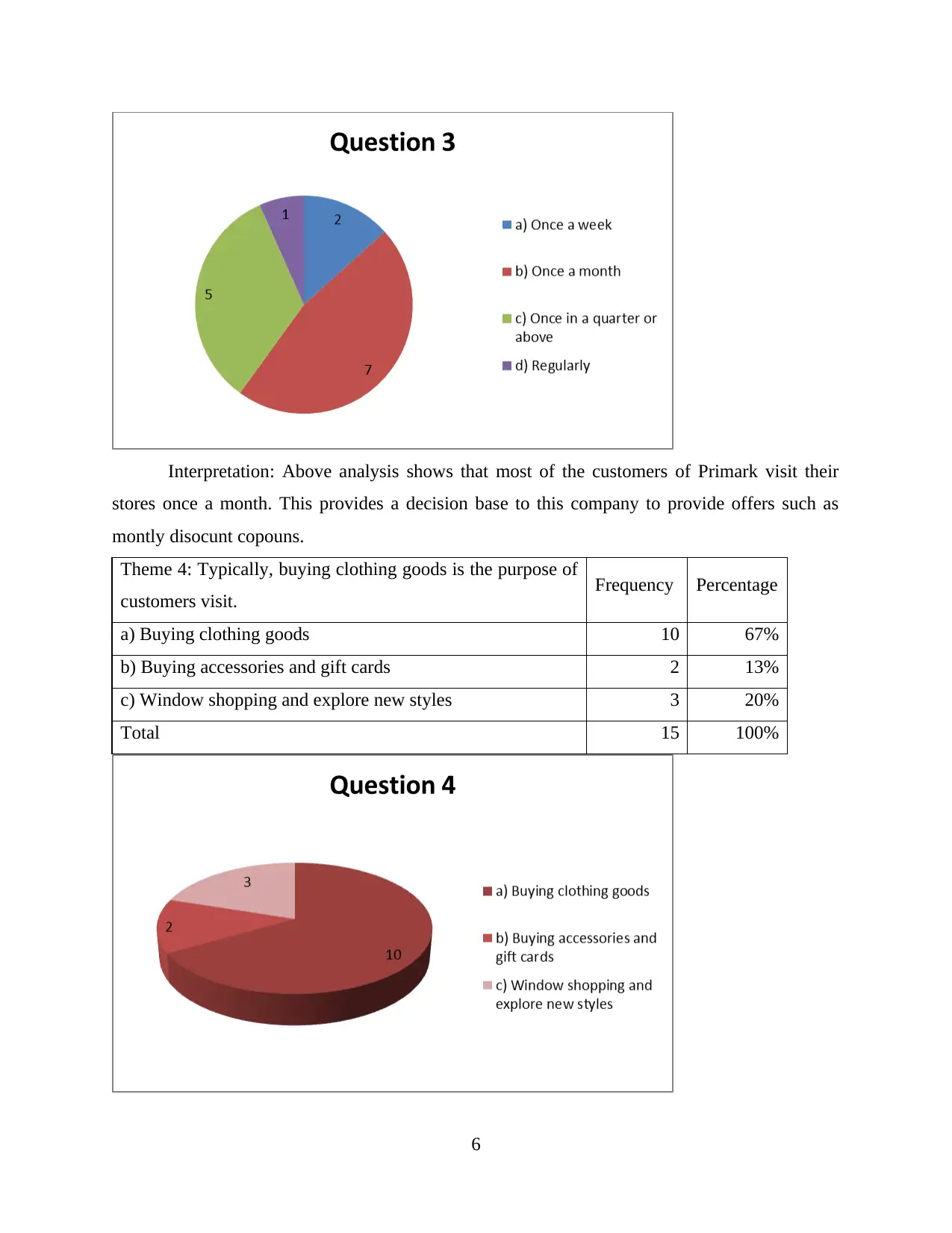
Interpretation: Above analysis shows that most of the customers of Primark visit their
stores once a month. This provides a decision base to this company to provide offers such as
montly disocunt copouns.
Theme 4: Typically, buying clothing goods is the purpose of
customers visit. Frequency Percentage
a) Buying clothing goods 10 67%
b) Buying accessories and gift cards 2 13%
c) Window shopping and explore new styles 3 20%
Total 15 100%
6
stores once a month. This provides a decision base to this company to provide offers such as
montly disocunt copouns.
Theme 4: Typically, buying clothing goods is the purpose of
customers visit. Frequency Percentage
a) Buying clothing goods 10 67%
b) Buying accessories and gift cards 2 13%
c) Window shopping and explore new styles 3 20%
Total 15 100%
6
⊘ This is a preview!⊘
Do you want full access?
Subscribe today to unlock all pages.

Trusted by 1+ million students worldwide
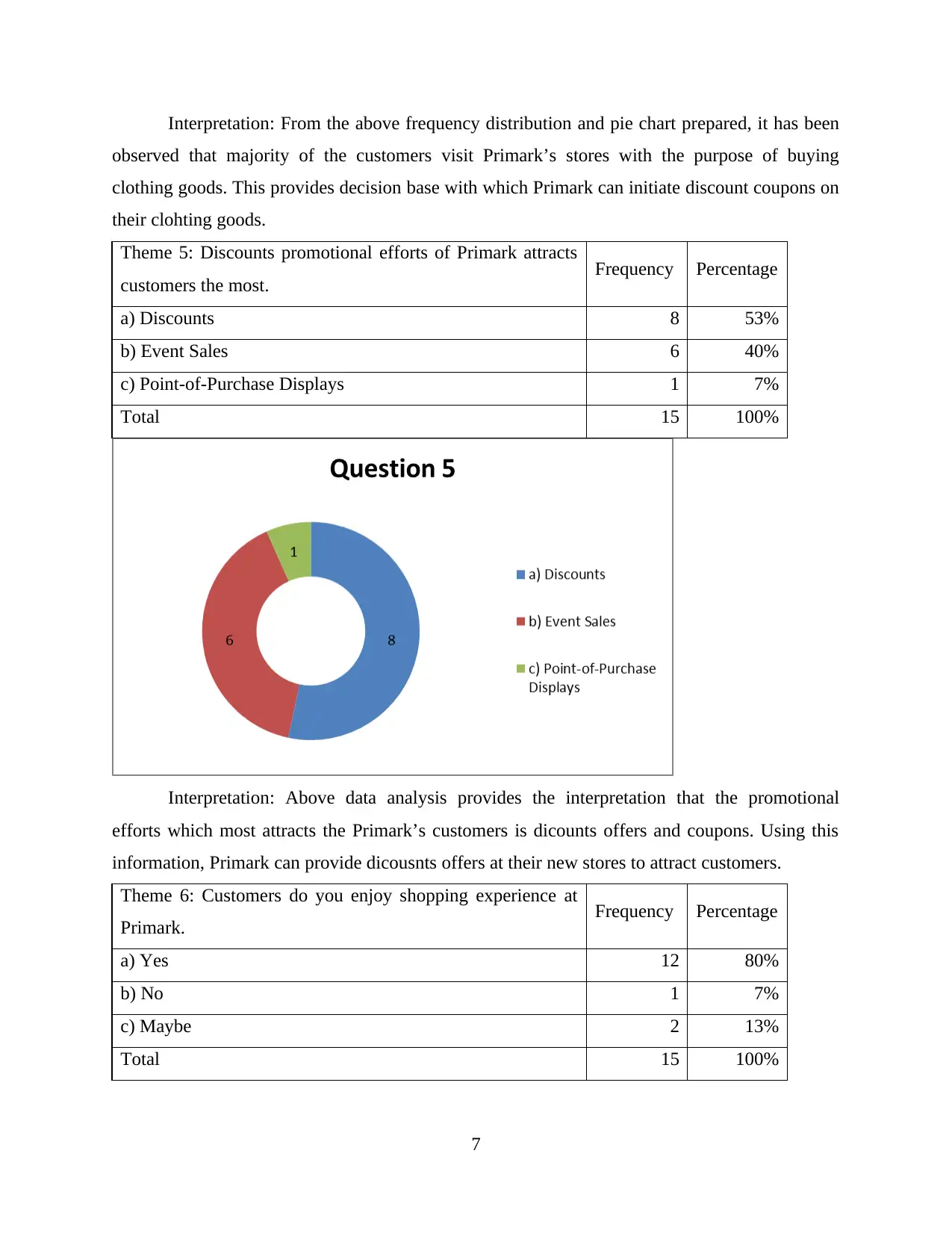
Interpretation: From the above frequency distribution and pie chart prepared, it has been
observed that majority of the customers visit Primark’s stores with the purpose of buying
clothing goods. This provides decision base with which Primark can initiate discount coupons on
their clohting goods.
Theme 5: Discounts promotional efforts of Primark attracts
customers the most. Frequency Percentage
a) Discounts 8 53%
b) Event Sales 6 40%
c) Point-of-Purchase Displays 1 7%
Total 15 100%
Interpretation: Above data analysis provides the interpretation that the promotional
efforts which most attracts the Primark’s customers is dicounts offers and coupons. Using this
information, Primark can provide dicousnts offers at their new stores to attract customers.
Theme 6: Customers do you enjoy shopping experience at
Primark. Frequency Percentage
a) Yes 12 80%
b) No 1 7%
c) Maybe 2 13%
Total 15 100%
7
observed that majority of the customers visit Primark’s stores with the purpose of buying
clothing goods. This provides decision base with which Primark can initiate discount coupons on
their clohting goods.
Theme 5: Discounts promotional efforts of Primark attracts
customers the most. Frequency Percentage
a) Discounts 8 53%
b) Event Sales 6 40%
c) Point-of-Purchase Displays 1 7%
Total 15 100%
Interpretation: Above data analysis provides the interpretation that the promotional
efforts which most attracts the Primark’s customers is dicounts offers and coupons. Using this
information, Primark can provide dicousnts offers at their new stores to attract customers.
Theme 6: Customers do you enjoy shopping experience at
Primark. Frequency Percentage
a) Yes 12 80%
b) No 1 7%
c) Maybe 2 13%
Total 15 100%
7
Paraphrase This Document
Need a fresh take? Get an instant paraphrase of this document with our AI Paraphraser
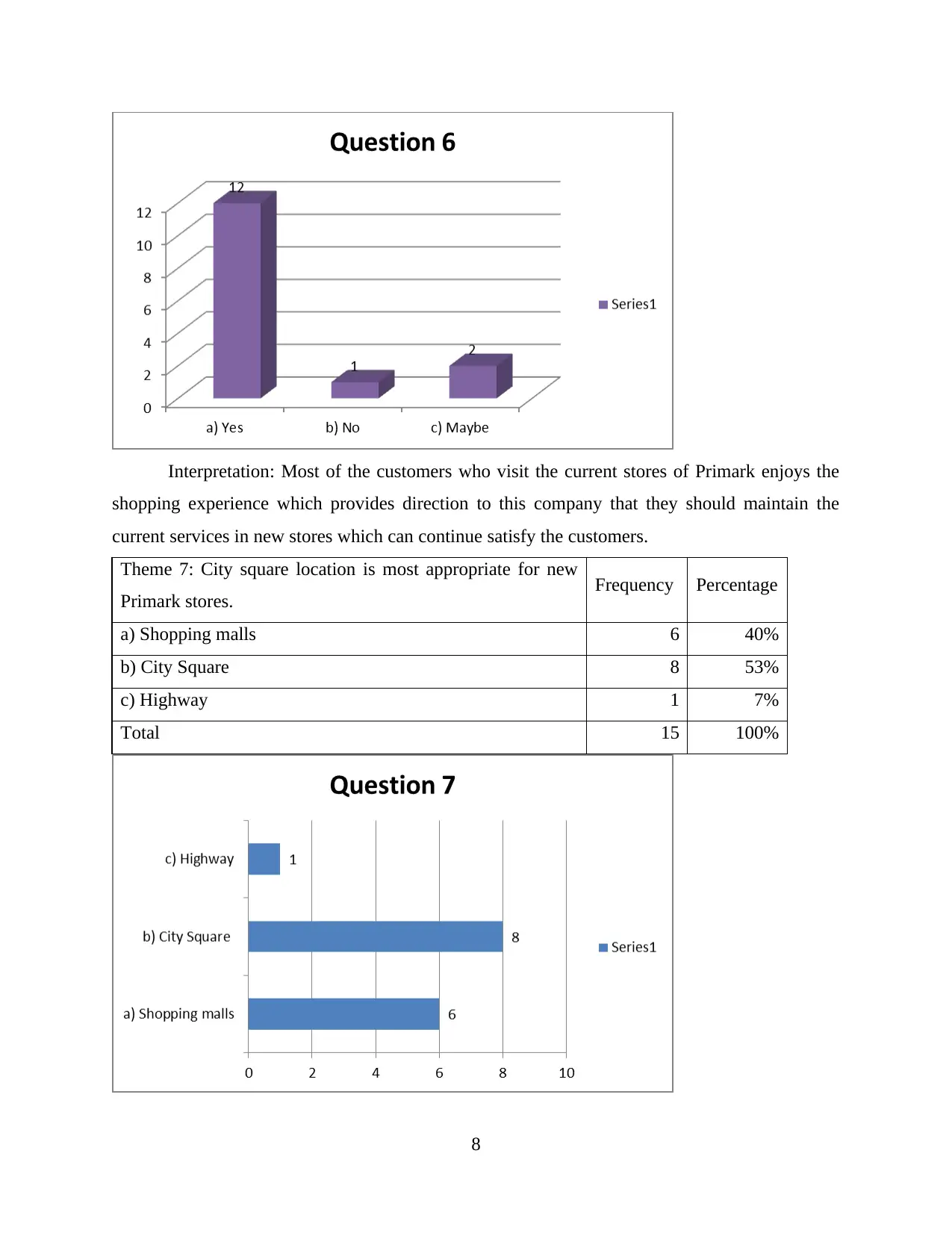
Interpretation: Most of the customers who visit the current stores of Primark enjoys the
shopping experience which provides direction to this company that they should maintain the
current services in new stores which can continue satisfy the customers.
Theme 7: City square location is most appropriate for new
Primark stores. Frequency Percentage
a) Shopping malls 6 40%
b) City Square 8 53%
c) Highway 1 7%
Total 15 100%
8
shopping experience which provides direction to this company that they should maintain the
current services in new stores which can continue satisfy the customers.
Theme 7: City square location is most appropriate for new
Primark stores. Frequency Percentage
a) Shopping malls 6 40%
b) City Square 8 53%
c) Highway 1 7%
Total 15 100%
8
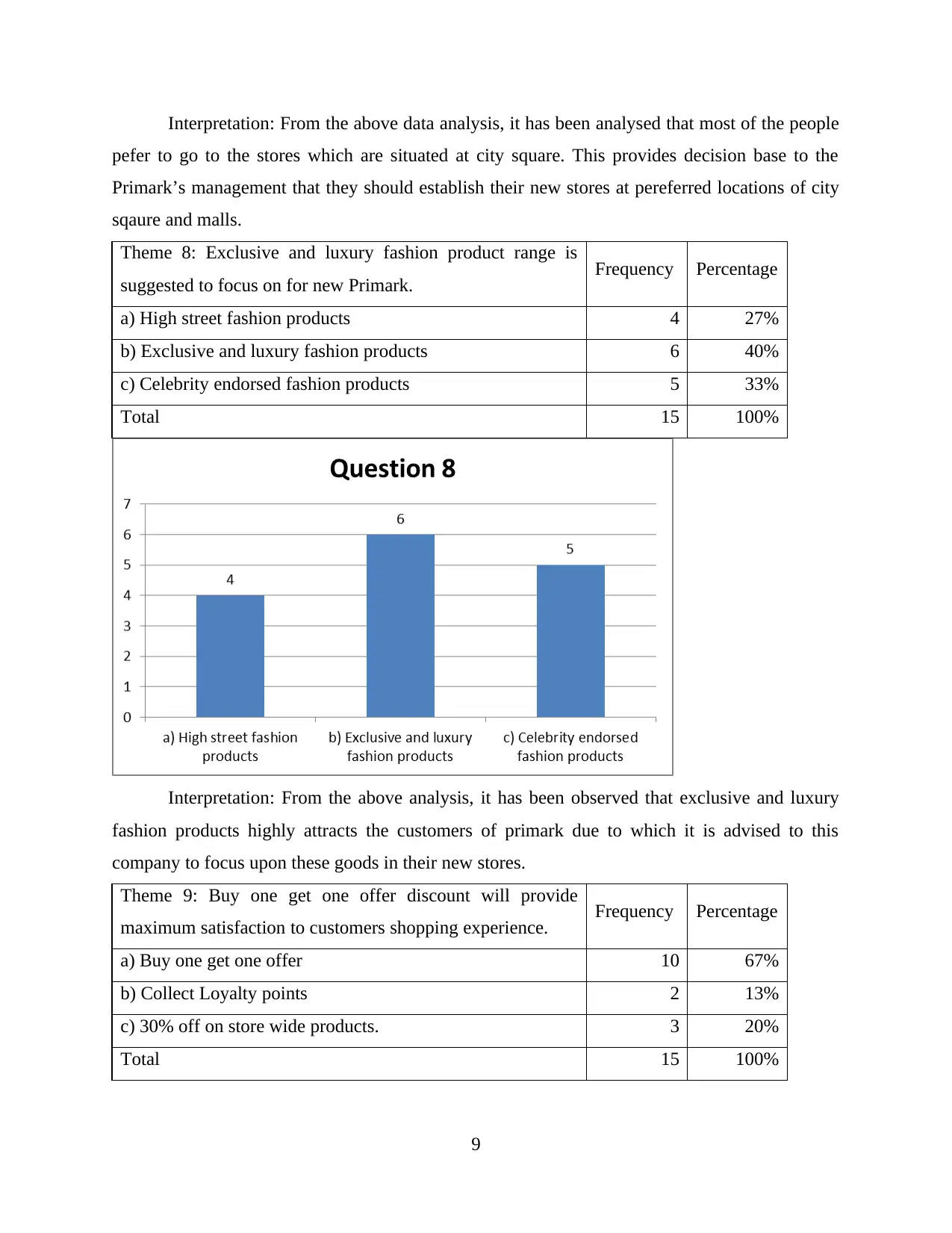
Interpretation: From the above data analysis, it has been analysed that most of the people
pefer to go to the stores which are situated at city square. This provides decision base to the
Primark’s management that they should establish their new stores at pereferred locations of city
sqaure and malls.
Theme 8: Exclusive and luxury fashion product range is
suggested to focus on for new Primark. Frequency Percentage
a) High street fashion products 4 27%
b) Exclusive and luxury fashion products 6 40%
c) Celebrity endorsed fashion products 5 33%
Total 15 100%
Interpretation: From the above analysis, it has been observed that exclusive and luxury
fashion products highly attracts the customers of primark due to which it is advised to this
company to focus upon these goods in their new stores.
Theme 9: Buy one get one offer discount will provide
maximum satisfaction to customers shopping experience. Frequency Percentage
a) Buy one get one offer 10 67%
b) Collect Loyalty points 2 13%
c) 30% off on store wide products. 3 20%
Total 15 100%
9
pefer to go to the stores which are situated at city square. This provides decision base to the
Primark’s management that they should establish their new stores at pereferred locations of city
sqaure and malls.
Theme 8: Exclusive and luxury fashion product range is
suggested to focus on for new Primark. Frequency Percentage
a) High street fashion products 4 27%
b) Exclusive and luxury fashion products 6 40%
c) Celebrity endorsed fashion products 5 33%
Total 15 100%
Interpretation: From the above analysis, it has been observed that exclusive and luxury
fashion products highly attracts the customers of primark due to which it is advised to this
company to focus upon these goods in their new stores.
Theme 9: Buy one get one offer discount will provide
maximum satisfaction to customers shopping experience. Frequency Percentage
a) Buy one get one offer 10 67%
b) Collect Loyalty points 2 13%
c) 30% off on store wide products. 3 20%
Total 15 100%
9
⊘ This is a preview!⊘
Do you want full access?
Subscribe today to unlock all pages.

Trusted by 1+ million students worldwide
1 out of 18
Related Documents
Your All-in-One AI-Powered Toolkit for Academic Success.
+13062052269
info@desklib.com
Available 24*7 on WhatsApp / Email
![[object Object]](/_next/static/media/star-bottom.7253800d.svg)
Unlock your academic potential
Copyright © 2020–2025 A2Z Services. All Rights Reserved. Developed and managed by ZUCOL.





